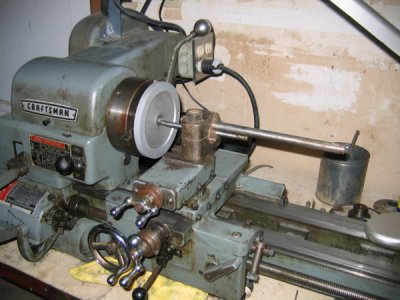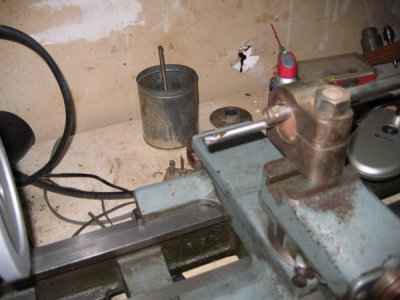- Joined
- Oct 31, 2016
- Messages
- 2,720
Hi,
I needed to increase the diameter of the shaft hole in a handwheel from 0.645 to 0.750. I mounted the handwheel in a 3 jaw chuck and I set up my boring bar on the compound. I brought the tip of the boring bar so that it just kissed the inside of the hole and set the dial to zero. I had taken out the backlash when I did this. All seems fine and I start by making a 0.002 cut. Next cut is 0.003. All goes well. So I start making 0.005 cuts. I am measuring the diameter after each cut. When I get the diameter to 0.700 I make 4 cuts of 0.005 without taking a measurement. I take a measurement and my diameter is 0.775. This is 0.025 too big. I was expecting the diameter to be 0.720.
My procedure on each cut was to 1) make the cut 2) back the boring well past zero 3) bring the boring bar out of the hole 4) advance the boring bar back to zero taking out all backlash and then bring boring bar back towards the work in the increments described above. I was basically counting backwards on the dial. The dial readings were 98,95,90,85,80,75,70,65,60,55.50,45,40,35, and lastly 30.
The only thing that I can think of is some how the cross slide moved.
Any ideas on what I did wrong?

I needed to increase the diameter of the shaft hole in a handwheel from 0.645 to 0.750. I mounted the handwheel in a 3 jaw chuck and I set up my boring bar on the compound. I brought the tip of the boring bar so that it just kissed the inside of the hole and set the dial to zero. I had taken out the backlash when I did this. All seems fine and I start by making a 0.002 cut. Next cut is 0.003. All goes well. So I start making 0.005 cuts. I am measuring the diameter after each cut. When I get the diameter to 0.700 I make 4 cuts of 0.005 without taking a measurement. I take a measurement and my diameter is 0.775. This is 0.025 too big. I was expecting the diameter to be 0.720.
My procedure on each cut was to 1) make the cut 2) back the boring well past zero 3) bring the boring bar out of the hole 4) advance the boring bar back to zero taking out all backlash and then bring boring bar back towards the work in the increments described above. I was basically counting backwards on the dial. The dial readings were 98,95,90,85,80,75,70,65,60,55.50,45,40,35, and lastly 30.
The only thing that I can think of is some how the cross slide moved.
Any ideas on what I did wrong?


